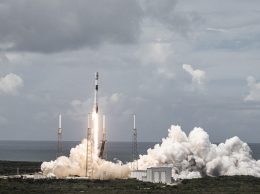SpaceX Lands Falcon 9 off Florida Coast
SpaceX landed a Falcon 9 rocket on a drone ship for the first time April 8 off the coast of Cape Canaveral, Fla.
The launch came only months after a Falcon 9 launched from Vandenberg Air Force Base failed to land successfully on a drone ship Jan 17. On Dec. 21, SpaceX landed a Falcon 9 on a launch pad near Cape Canaveral. Three previous attempts to land a rocket on a drone ship at sea were unsuccessful.
SpaceX wants to develop reusable rockets to save money on the cost of building new rockets for each launch. The company’s rockets cost between $60 million and $90 million. If the technology is developed correctly, it has the potential to drastically cut the cost of space travel.
A Jan. 17 launch from Vandenberg put a National Oceanic and Atmospheric Administration weather satellite into orbit. After the launch the rocket attempted to land on an unmanned drone ship off the coast of Southern California.
That rocket landed within 1.3 meters of the target on the drone ship. However, one of the rocket’s four legs did not lock properly so the rocket tipped over and exploded.
The April 8 rocket launched a SpaceX Dragon capsule on a cargo resupply mission to the International Space Station. On board the Dragon was the Bigelow Expandable Activity Module, or BEAM. The BEAM is an inflatable capsule.
We’re launching an expandable habitat to @Space_Station on @SpaceX #Dragon Friday. See why: https://t.co/OwFFoEx19w pic.twitter.com/A9xRCk96xE
— NASA (@NASA) April 5, 2016
When the Falcon 9 returned safely to earth, SpaceX tweeted out the good news.
Falcon 9 first stage on our droneship in the Atlantic after propelling the Dragon spacecraft to the @Space_Station pic.twitter.com/Cnnej7zEnt
— SpaceX (@SpaceX) April 8, 2016
SpaceX Founder and Tesla tycoon Elon Musk also tweeted about the good news.
1st stage has landed on Of Course I Still Love You https://t.co/tdni53IviI
— SpaceX (@SpaceX) April 8, 2016
Fans also tweeted out GIFs of the rocket landing.
Can’t stop watching. #SpaceX pic.twitter.com/S0MuuRMpmK
— David Beard (@dabeard) April 8, 2016
At just 300-feet long by 100-feet wide, the drone ship is a small target. Legs on the first stage of the Falcon 9 are 70-feet wide but the ship is not anchored and moves in the sea. Landing on dry land is easier, but landing at sea is safer.
SpaceX started conducting tests at Vandenberg in 2005 and currently leases a launch pad at Vandenberg from the Air Force. In February 2015, it also signed a five-year lease on a second pad the company will use to land rockets on dry land.
Both pads were built in the 1960s for early Atlas rockets and modified in the 1970s for the Titan family of rockets. SpaceX demolished structures at the second pad in September 2014 to make it easier to complete landings.
Falcon 9 launches from Vandenberg are currently scheduled for some time in May and some time in July. It’s expected that at least one of those launches will attempt to land on dry land.
• Contact Philip Joens at [email protected].










